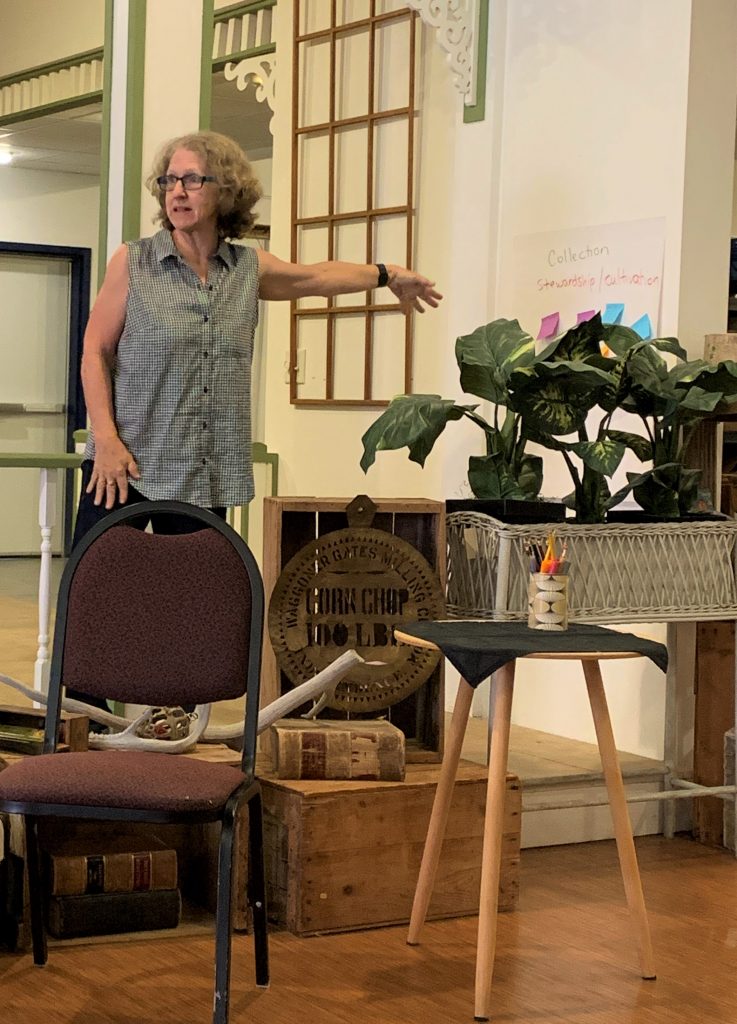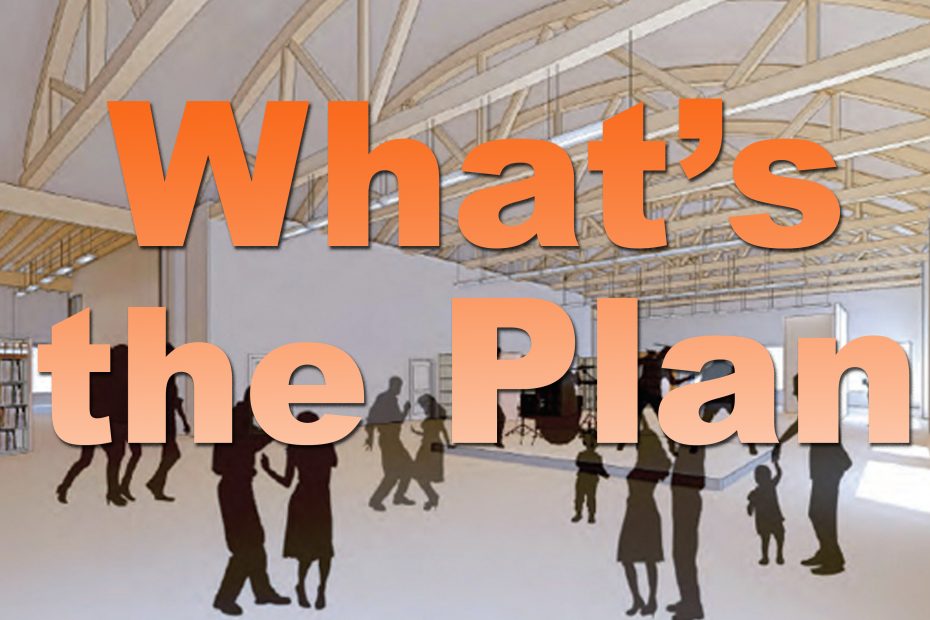
Long-Range Planning Meeting Notes
Held on Thursday, September 8, 2022, 3:30 to 5:00 pm
Note: This long-range planning meeting was an open meeting held in lieu of the monthly meeting of the Board of Directors.
In attendance: Brenda Allison, Jeff Kellogg, Karen Mencel, Suzan Nash, Sheila Nollan, Gary Neuhardt, Tim Roberts, Sue Scott, Carol Sims, and Anne Vick. The meeting was facilitated by Janet Cobb.
First exercise: Participants were asked to respond to the following prompts to consider how a museum functions in the dynamic cycle of past, present, and future.
Rural:
- Regional -encompassing 16 to 20 counties
- Farming and agriculture
- Isolation/Distant
- Mutual assistance
- No crowds
- Self-reliance
- Acceptance of the world
- Idyllic
- Room to grow – breath
- Being more in touch with the natural world/nature
- Farm
- Environment/ Landscape
- Less density populated
- Ties to the land
- A way of life
- Slower
- Emphasis on nature
- Animals birds
- Machinery
- Innovation from necessity
- Our roots
- Hick town
- Small world view
- Out of date
- Xenophobia
- Conservatism
Museum:
- Workshops
- Folkways
- Disruptions
- Participation
- Learning
- Exploration
- Adventure
- A place to bring people to the area
- Using our leisure time
- Presenting stories about people and objects
- Collection
- Guardian
- Transformation
- Illuminating
- Trusted
- A “do not disturb” atmosphere
- A place that holds and is an expression of history
- Collection on shelf
- Open
- History
- Architecture
- Landscape
Defining Core Values
Next, people were asked to respond to the core values being considered. Then small groups worked to weave together the responses to make a definition or statement about each value.
Connection
- Who has been left out
- Brings community
- Collective experience
- Reaching out to those who may feel disenfranchised
- Face-to-face interactions with visitors
- Be able to answer the questions about artifacts
- Know where to find information for guests
- Person to Person, past to present, person to past, person to place
- Give people a chance to tell their story
“Make a connection to the community with outreach programs, one-on-one interactions, and letting people tell their stories.”
Collection: Stewardship and cultivation
- Shared values
- Culture
- Precious stuff
- Descriptive history
- Local history with artifacts that have local meaning
- A starting point for curiosity – “my mom had one of those”
- Find what interests the community
- Not just the unique but also the mundane; level of use = importance
- From collecting to planting to cultivation
- When do we say no to an item and not want to add it to the collection
“Stewardship is an act of cultivating, assessing, and preserving what our community values for others to benefit from. Stewardship takes clarity to identify what makes an item or story important not just unique and tenacity to ensure cultivation is equitable and thorough.”
Curiosity
- What are the gaps in my knowledge of this place of the others who have lived here?
- What is this and how does it work? Who are the people who own it?
- From Oddity to instrument
- I’d like to see themed topical issues discussed such as how to avoid mistakes in the future
- Activities based on curiosity
- Life long learning
“Curiosity helps us identify the gaps in our knowledge and to ask questions. It moves us from something being an oddity to being an instrument to discuss and learn from our mistakes. Activity-based educational programs can help us become curious and life-long learners.”
Community
- From learning is forever to one room school house
- People/their values
- People/history and impact
- A gathering place to meet friends
- A place to meet new people and expand our community
- People
- How does our present reflect the past
- Create/encourage
- Dynamic/inviting/open “we” that desires to learn about
- The community is the connection
- Shared values
- Acceptance
- Do things that draw disparate groups of people together
“Community: Create and maintain an inviting, dynamic “circle of the we” whose constituents share a desire to learn how the present reflects the past.”
Courage: Risk-taking/Disrupter
- Pieces of history that aren’t pretty but are important to know and move forward
- From nostalgia to exposure
- We need to explore/examine the edgier (controversial) topics in the past/present/future framework
- Courage to explore ideas not available in the Rural area
- Challenge authority
- Don’t be afraid to take on controversial topics in exhibits
“Courage: Be curious about all of our history, not just the nostalgic. Expose negative aspects of our history despite potential blowback. Discuss history to ensure that mistakes are not repeated in the future.”
| Planning Process Overview We invite you to join us for a series of conversations to develop a long-range plan for the Western Illinois Museum. Our facilitator for the conversations will be Janet Cobb, a nonprofit coach who has been working with the Museum staff for the last year. Why we need your help In 2018 the Museum created a long-range plan that we preferred to call a “doing plan” and it had three “things to do” or goals. 1. Experiment with a participatory approach to running a museum This goal resulted in the development of the Blind Swine Speakeasy and the Our Front Porch. Both program initiatives were well received and have helped to solidify the “participator approach” to running the Museum. Here is a short video about this approach: https://youtu.be/aIcwIH1vZ9w 2. Complete south and east façade improvements including installing new windows This project was completed in 2019 and gave us a glimpse of what the building, with all the windows replaced, could look like. 3. Develop and launch a capital campaign This included creating a facilities plan with the architectural firm, HPZS, and the successful launch of the Renovate to Innovate Capital Campaign in February 2021. The 2018 long-range plan was key to the last three years being so productive for the Museum. With these goals accomplished and renovations transforming the Museum, it’s time to build on this plan. We are asking those who know us best to work with us in identifying areas to continue this trajectory. Three conversations are planned -Thursday, August 18th at 4:30 on ZOOM -Thursday, September 8th at 3:30 pm at the Museum, and Janet will join us in person -September 22nd at 4:30 on ZOOM Where the conversation will begin The big question on the table is how to optimize organizational infrastructure for needed growth. Here are a couple of areas that we want to explore: -Exhibit development and research -Audience development -Governance Questions to get you thinking What does growth mean to you? What does participation mean to you? How could we be more welcoming, inclusive, and accessible? What policies and procedures, or systems and structures could prepare us for growth? |
 Meet our Facilitator Janet CobbJanet has worked in the nonprofit arena her entire career. As a Certified Fund Raising Executive and Certified Nonprofit Professional, Janet specializes in working with small to medium nonprofit organizations across the country to help them build capacity and acquire the skills needed to support and expand their efforts. From growing development efforts from the ground up to working in well-established offices, Janet brings the knowledge and understanding of the challenges faced by small nonprofits to each of her projects. Janet has held a wide variety of positions including Communications Manager, Director of Development and Executive Director, and handled budgets from under $50K to $8m. She integrates her skills in education, non-profit management, and fundraising to offer innovative solutions to align money and mission. Through the course of her 30+ year career, Janet has worked with more than 500 nonprofits and participated in or facilitated numerous and varied strategic planning initiatives. Her experience has led her to develop a right-sized strategic planning process for small to medium nonprofits, balancing the grand vision with the practical capacity of the organization. Janet Cobb brings vision to current reality and reality to big bold visions as she assists organizations in their efforts to do good. Meet our Facilitator Janet CobbJanet has worked in the nonprofit arena her entire career. As a Certified Fund Raising Executive and Certified Nonprofit Professional, Janet specializes in working with small to medium nonprofit organizations across the country to help them build capacity and acquire the skills needed to support and expand their efforts. From growing development efforts from the ground up to working in well-established offices, Janet brings the knowledge and understanding of the challenges faced by small nonprofits to each of her projects. Janet has held a wide variety of positions including Communications Manager, Director of Development and Executive Director, and handled budgets from under $50K to $8m. She integrates her skills in education, non-profit management, and fundraising to offer innovative solutions to align money and mission. Through the course of her 30+ year career, Janet has worked with more than 500 nonprofits and participated in or facilitated numerous and varied strategic planning initiatives. Her experience has led her to develop a right-sized strategic planning process for small to medium nonprofits, balancing the grand vision with the practical capacity of the organization. Janet Cobb brings vision to current reality and reality to big bold visions as she assists organizations in their efforts to do good. Strategic Planning ApproachJanet’s approach to strategic planning integrates 20+ years as a classroom teacher, professional development facilitator, and curriculum developer. Employing a casual, conversational tone, Janet facilitates a participant-driven discussion, providing support while gently challenging assumptions and guiding participants towards consensus, or agreed-upon compromise. Janet invites participants to articulate their passions, fears, and hopes, to capture the details needed to articulate a vision, confirm the mission, and clearly and concisely develop overarching goals, specific objectives, and action steps to achieve those goals. The final step involves developing an implementation plan with measurable outcomes and timelines to hold participants accountable to one another once the strategic plan has been ratified. |
